Non-Invasive Estimation of Machining Parameters during End-Milling Operations Based on Acoustic Emission
Abstract
:1. Introduction
Acoustic Emission
2. Geometrical Model of the End-Milling Process
3. Cutting Force Model
4. Materials and Methods
4.1. Prototype Measuring System
4.1.1. Stage 1: Generation of Cutting Force Reference Signal
4.1.2. Stage 2: Estimation of Depth of Cut Using the Adaptive Filter
4.1.3. Stage 3: Calibration and Correction Factor
4.2. Experimental Setup
5. Results and Discussion
5.1. Qualitative Waveform Analysis
5.2. Performance of the Prototype Measurement System
5.3. Precision of the Proposed Method
6. Conclusions
Author Contributions
Funding
Acknowledgments
Conflicts of Interest
Correction Statement
Abbreviations
| AE | Acoustic Emission |
| ae | Radial depth of cut, mm |
| aei | Axial depth of cut, mm |
| api | Axial depth of cut of the flute i, mm |
| apa | Actual axial depth of cut, mm |
| en | Entry angle, rad |
| eni | Entry angle of flute i, rad |
| pr | Projected angle of the cutting edge, rad |
| Fx | Cutting force in X direction, N |
| T | Period of spindle rotation, s |
| D | Tool diameter, mm |
| fz | Feed per tooth, mm |
| n | Spindle speed, rpm |
| N | Tool flute number, - |
| s | Tool helix angle, rad |
References
- Yan, R.; Tang, X.; Peng, F.Y.; Wang, Y.; Qiu, F. The effect of variable cutting depth and thickness on milling stability for orthogonal turn-milling. Int. J. Adv. Manuf. Technol. 2016, 82, 765–777. [Google Scholar] [CrossRef]
- Zhang, Z.; Luo, M.; Zhang, D.; Wu, B. A force-measuring-based approach for feed rate optimization considering the stochasticity of machining allowance. Int. J. Adv. Manuf. Technol. 2018, 97, 2545–2556. [Google Scholar] [CrossRef]
- Leal-Muñoz, E.; Diez, E.; Perez, H.; Vizan, A. Accuracy of a new online method for measuring machining parameters in milling. Measurement 2018, 128, 170–179. [Google Scholar] [CrossRef]
- Prickett, P.W.; Siddiqui, R.A.; Grosvenor, R.I. Accuracy of a new online method for measuring machining parameters in milling. Int. J. Adv. Manuf. Technol. 2011, 52, 89–100. [Google Scholar] [CrossRef]
- Castaño, F.; Haber, R.E.; del Toro, R.M. Characterization of tool-workpiece contact during the micromachining of conductive materials. Mech. Syst. Signal Process. 2017, 83, 489–505. [Google Scholar] [CrossRef]
- Castaño, F.; Toro, R.M.; Del Haber, R.E.; Beruvides, G. Conductance sensing for monitoring micromechanical machining of conductive materials. Sens. Actuators A Phys. 2015, 232, 163–171. [Google Scholar]
- Marinescu, I.; Axinte, D.A. A critical analysis of effectiveness of acoustic emission signals to detect tool and workpiece malfunctions in milling operations. Int. J. Mach. Tools Manuf. 2008, 48, 1148–1160. [Google Scholar] [CrossRef]
- Axinte, D.; Marinescu, I. A time-frequency acoustic emission-based monitoring technique to identify workpiece surface malfunctions in milling with multiple teeth cutting simultaneously. Int. J. Mach. Tools Manuf. 2009, 41, 53–65. [Google Scholar]
- Sun, S.; Hu, X.; Zhang, W. Detection of tool breakage during milling process through acoustic emission. Int. J. Adv. Manuf. Technol. 2020, 109, 1409–1418. [Google Scholar] [CrossRef]
- Ahmed, S.; Arif, Y.; Veldhuis, A.F.M.; Clarence, S. Application of the wavelet transform to acoustic emission signals for built-up edge monitoring in stainless steel machining. Meas. J. Int. Meas. Confed. 2020, 154, 107478. [Google Scholar] [CrossRef]
- Seemuang, N.; McLeay, T.; Slatter, T. Using spindle noise to monitor tool wear in a turning process. Int. J. Adv. Manuf. Technol. 2016, 86, 2781–2790. [Google Scholar] [CrossRef]
- Shankar, S.; Mohanraj, T.; Rajasekar, R. Prediction of cutting tool wear during milling process using artificial intelligence techniques. Int. J. Comput. Integr. Manuf. 2019, 32, 174–182. [Google Scholar] [CrossRef]
- Prakash, K.; Samraj, A. Tool Flank Wears Estimation by Simplified SVD on Emitted Sound Signals. In Proceedings of the 2017 Conference on Emerging Devices and Smart Systems (ICEDSS), Tiruchengode, India, 3–4 March 2017; pp. 1–5. [Google Scholar]
- Lee, R.M.; Liu, P.T.; Wang, C.C. Investigation of milling stability under cutting fluid supply by microphone signal analysis. Sens. Mater. 2018, 30, 2419–2428. [Google Scholar] [CrossRef]
- Shrivastava, Y.; Singh, B. Estimation of stable cutting zone in turning based on empirical mode decomposition and statistical approach. J. Braz. Soc. Mech. Sci. Eng. 2018, 40, 77. [Google Scholar] [CrossRef]
- Kilic, Z.M.; Altintas, Y.; Caliskan, H. On-line energy-based milling chatter detection. J. Manuf. Sci. Eng. 2018, 140, 1–12. [Google Scholar]
- Lee, W.-C.; Cheng, H.-C.; Wei, C.-C. Development of a machining monitoring and chatter suppression device. In Proceedings of the 2018 IEEE Industrial Cyber-Physical Systems (ICPS), St. Petersburg, Russia, 15–18 May 2018; Volume 18, pp. 404–408. [Google Scholar]
- Lee, W.C.; Cheng, H.C.; Wei, C.C. Implementation of an Add-on Device that Monitors the Sound of a Machine Tool and Automatically Suppresses Chatter. Sens. Mater. 2019, 31, 3575–3582. [Google Scholar] [CrossRef]
- Zhu, L.; Liu, C. Recent progress of chatter prediction, detection and suppression in milling. Mech. Syst. Signal Process. 2020, 143, 106840. [Google Scholar] [CrossRef]
- Onwuka, G.; Abou-El-Hossein, K.T. Surface Roughness in Ultra-high Precision Grinding of BK7. Procedia CIRP 2016, 45, 143–146. [Google Scholar] [CrossRef]
- Ribeiro, K.S.B.; Venter, G.S.; Rodrigues, A.R. Experimental correlation between acoustic emission and stability in micromilling of different grain-sized materials. Int. J. Adv. Manuf. Technol. 2020, 109, 2173–2187. [Google Scholar] [CrossRef]
- Yan, G.; Wu, Y.; Cristea, D.; Liu, L.; Tierean, M.; Wang, Y.; Lu, F.; Wang, H.; Yuan, Z.; Munteanu, D.; et al. Mechanical properties and wear behavior of multi-layer diamond films deposited by hot-filament chemical vapor deposition. Appl. Surf. Sci. 2019, 494, 401–411. [Google Scholar] [CrossRef]
- Dong, C.; Mo, J.; Yuan, C.; Bai, X.; Tian, Y. Vibration and Noise Behaviors During Stick–Slip Friction. Tribol. Lett. 2019, 67. [Google Scholar] [CrossRef]
- Srinivasan, A.; Bhinge, R.; Dornfeld, D. Integrated vibration and acoustic data data fusion for chatter and tool classification in milling. In Proceedings of the ISFA 2016, 2016 International Symposium on Flexible Automation, Cleveland, OH, USA, 1–3 August 2016; pp. 263–266. [Google Scholar]
- Gaja, H.; Liou, F. Depth of cut monitoring for hybrid manufacturing using acoustic emission sensor. In Proceedings of the 26th Annual International Solid Freeform Fabrication Symposium, Austin, TX, USA, 10–12 August 2015. [Google Scholar]
- Zhang, X.; Chen, H.; Xu, J.; Song, X.; Wang, J.; Chen, X. A novel sound-based belt condition monitoring method for robotic grinding using optimally pruned extreme learning machine. J. Mater. Process. Technol. 2018, 260, 9–19. [Google Scholar] [CrossRef]
- Bejaxhin, A.B.H.; Paulraj, G. Experimental investigation of vibration intensities of CNC machining centre by microphone signals with the effect of TiN/epoxy coated tool holder. J. Mech. Sci. Technol. 2019, 33, 1321–1331. [Google Scholar] [CrossRef]
- Nasir, V.; Cool, J.; Sassani, F. Intelligent Machining Monitoring Using Sound Signal Processed with the Wavelet Method and a Self-Organizing Neural Network. IEEE Robot. Autom. Lett. 2019, 4, 3449–3456. [Google Scholar] [CrossRef]
- Shehadeh, M.F.; Elbatran, A.H.; Mehanna, A.; Steel, J.A.; Reuben, R.L.A. Evaluation of Acoustic Emission Source Location in Long Steel Pipes for Continuous and Semi-continuous Sources. J. Nondestruct. Eval. 2019, 38, 40. [Google Scholar] [CrossRef]
- Shanyavskiy, A.; Banov, M. Acoustic emission methods for lifetime estimations in aircraft structures. Theor. Appl. Fract. Mech. 2020, 109, 102719. [Google Scholar] [CrossRef]
- Liu, Z.; Wang, X.; Zhang, L. Fault Diagnosis of Industrial Wind Turbine Blade Bearing Using Acoustic Emission Analysis. IEEE Trans. Instrum. Meas. 2020, 69, 6630–6639. [Google Scholar] [CrossRef]
- Dai, Y.; Xue, Y.; Zhang, J. Bioinspired Integration of Auditory and Haptic Perception in Bone Milling Surgery. IEEE/ASME Trans. Mech. 2018, 23, 614–623. [Google Scholar] [CrossRef]
- Ianasaki, I.; Toensho, H.K. Sensors in Manufacturing. In Sensors in Manufacturing; Wiley-VCH: Weinheim, Germany, 2001. [Google Scholar]
- Faudzi, A.A.M.; Sabzehmeidani, Y.; Suzumori, K. Application of micro-electro-mechanical systems (MEMS) as sensors: A review. J. Robot. Mech. 2020, 32, 281–288. [Google Scholar] [CrossRef]
- Băjenescu, T.-M.I. Manufacturing, encapsulation and reliability of micro-and nano-sensors. EEA Electr. Electron. Autom. 2020, 68, 21–27. [Google Scholar]
- Kim, H.; Jung, W.-Y.; Choi, I.-G.; Ahn, S.-H. A Low-Cost Vision-Based Monitoring of Computer Numerical Control (CNC) Machine Tools for Small and Medium-Sized Enterprises (SMEs). Sensors 2019, 19, 4506. [Google Scholar] [CrossRef] [PubMed]
- Modica, F.; Basile, V.; Ruggeri, S.; Fontana, G.; Fassi, I. Can A Low Cost Sensing System Be Exploited for High Precision Machining? In Proceedings of the 15th CIRP Conference on Computer Aided Tolerancing, Milan, Italy, 11–13 June 2018; pp. 391–396. [Google Scholar]
- Narayanan, A.; Kanyuck, A.; Gupta, S.K.; Rachuri, S. Machine condition detection for milling operations using low cost ambient sensors. In Proceedings of the ASME 2016 International Manufacturing Science and Engineering Conference, Blacksburg, VA, USA, 27 June–1 July 2016. MSEC2016-8666. [Google Scholar]
- Biermann, D.; Zabel, A.; Brüggemann, T.; Barthelmey, A. A comparison of low cost structure-borne sound measurement and acceleration measurement for detection of workpiece vibrations in 5-axis simultaneous machining. Procedia CIRP 2013, 12, 1–96. [Google Scholar] [CrossRef]
- Kumar, P.; Morawska, L.; Martani, C.; Biskos, G.; Neophytou, M.; Di Sabatino, S.; Bell, M.; Norford, L.; Britter, R. The rise of low-cost sensing for managing air pollution in cities. Environ. Int. 2015, 75, 199–205. [Google Scholar] [CrossRef] [PubMed]
- Castell, N.; Dauge, F.R.; Schneider, P.; Vogt, M.; Lerner, U.; Fishbain, B.; Broday, D.; Bartonova, A. Can commercial low-cost sensor platforms contribute to air quality monitoring and exposure estimates? Environ. Int. 2017, 99, 293–302. [Google Scholar] [CrossRef]
- Sofia, D.; Giuliano, A.; Gioiella, F. Air quality monitoring network for tracking pollutants: The case study of Salerno city center. Chem. Eng. Trans. 2018, 68, 67–72. [Google Scholar]
- Ham, S.; Popovics, J.S. Application of micro-electro-mechanical sensors contactless NDT of concrete structures. Sensors 2015, 15, 9078–9096. [Google Scholar] [CrossRef]
- Reich, C.; Mansour, A.; Van Laerhoven, K. European Signal Processing Conference. In Proceedings of the European Signal Processing Conference, Roma, Italy, 3–7 September 2018; pp. 371–375. [Google Scholar]
- Kazari, H.; Ozevin, D. Multi frequency acoustic emission micromachined transducers for structural health monitoring. In Proceedings of the 12th International Workshop on Structural Health Monitoring, Stanford, CA, USA, 10–12 September 2019; Volume 1, pp. 72–79. [Google Scholar]
- Raviola, E.; Fiori, F. A Low-Cost, Small-Size, and Bluetooth-Connected Module to Detect Faults in Rolling Bearings. Appl. Sci. 2020, 10, 5645. [Google Scholar] [CrossRef]
- Fragiacomo, G.; Reck, K.; Lorenzen, L.; Thomsen, E.V. Novel designs for application specific MEMS pressure sensors. Sensors 2010, 110, 9541–9563. [Google Scholar] [CrossRef]
- Lee, D.E.; Hwang, I.; Valente, C.M.O.; Oliveira, J.F.G.; Dornfeld, D.A. Precision manufacturing process monitoring with acoustic emission. IEEE Robot. Autom. Lett. 2006, 46, 176–188. [Google Scholar]
- Möhring, H.-C.; Kimmelmann, M.; Eschelbacher, S.; Güzel, K.; Gauggel, C. Process monitoring on drilling fiber-reinforced plastics and aluminum stacks using acoustic emissions. Procedia Manuf. 2018, 18, 58–67. [Google Scholar] [CrossRef]
- Jemielniak, K.; Kossakowska, J.; Urbański, T. Application of wavelet transform of acoustic emission and cutting force signals for tool condition monitoring in rough turning of Inconel 625. Proc. Inst. Mech. Eng. Part B J. Eng. Manuf. 2011, 225, 123–129. [Google Scholar] [CrossRef]
- O’Donnell, G.; Dornfeld, D.; Teti, R.; Jemielniak, K. Advanced monitoring of machining operations. CIRP Ann. Manuf. Technol. 2010, 59, 717–739. [Google Scholar]
- Gaja, H.; Liou, F. Automatic detection of depth of cut during end milling operation using acoustic emission sensor. Int. J. Adv. Manuf. Technol. 2016, 86, 2913–2925. [Google Scholar] [CrossRef]
- Srdjovic, J.; Anicic, O.; Jovanovic, M. Adaptive neuro-fuzzy fusion of multi-sensor data for monitoring of CNC machining. Sens. Rev. 2017, 37, 78–81. [Google Scholar]
- Ren, Q.; Baron, L.; Balazinski, M.; Botez, R.; Bigras, P. Tool wear assessment based on type-2 fuzzy uncertainty estimation on acoustic emission. Appl. Soft Comput. J. 2015, 31, 14–24. [Google Scholar] [CrossRef]
- Miranda, H.I.; Rocha, C.A.; Oliveira, P.; Martins, C.; Aguiar, P.R.; Bianchi, E.C.P.R.; Bianchi, E.C. Monitoring single-point dressers using fuzzy models. Procedia CIRP 2015, 33, 281–286. [Google Scholar] [CrossRef]
- Aguiar, P.R.; Da Silva, R.B.; Gerônimo, T.M.; Franchin, M.N.; Bianchi, E.C. Estimating high precision hole diameters of aerospace alloys using artificial intelligence systems: A comparative analysis of different techniques. J. Braz. Soc. Mech. Sci. Eng. 2017, 39, 127–153. [Google Scholar] [CrossRef]
- Nakai, M.E.; Guillardi, H.; Aguiar, P.R.; Bianchi, E.C.; Da Silva, P.S. Evaluation of neural models to estimate the roughness of advanced ceramics in surface grinding. Int. J. Mach. Mach. Mater. 2015, 17, 454–479. [Google Scholar] [CrossRef]
- Pan, W.; Pan, W.; Wu, Y.; Guo, L. New method for the calibration of cutter runout parameters in milling process. IOP Conf. Ser. Mater. Sci. Eng. 2019, 688. [Google Scholar] [CrossRef]



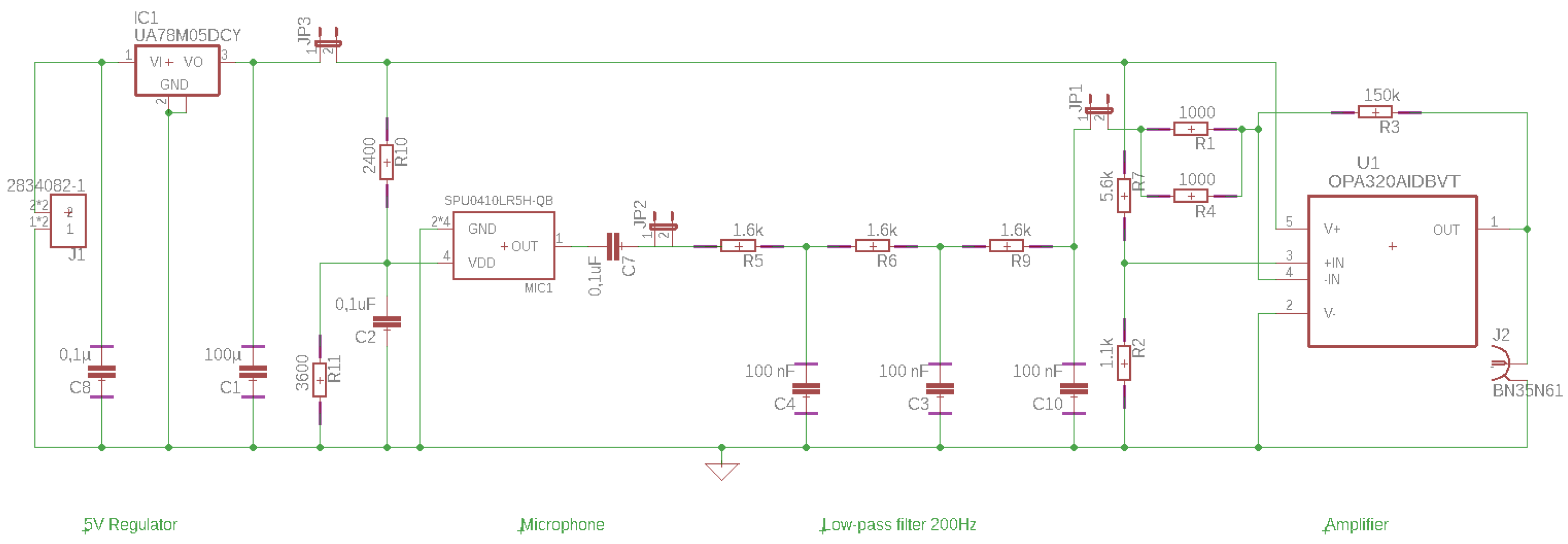
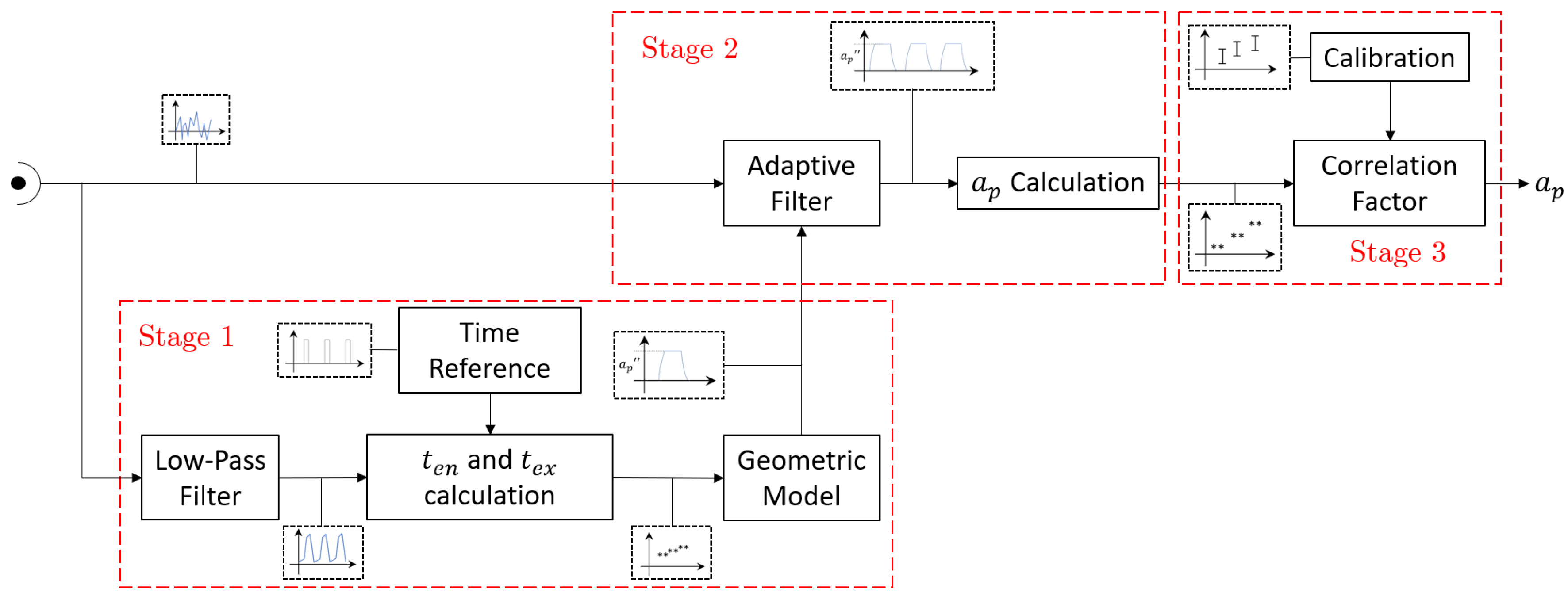
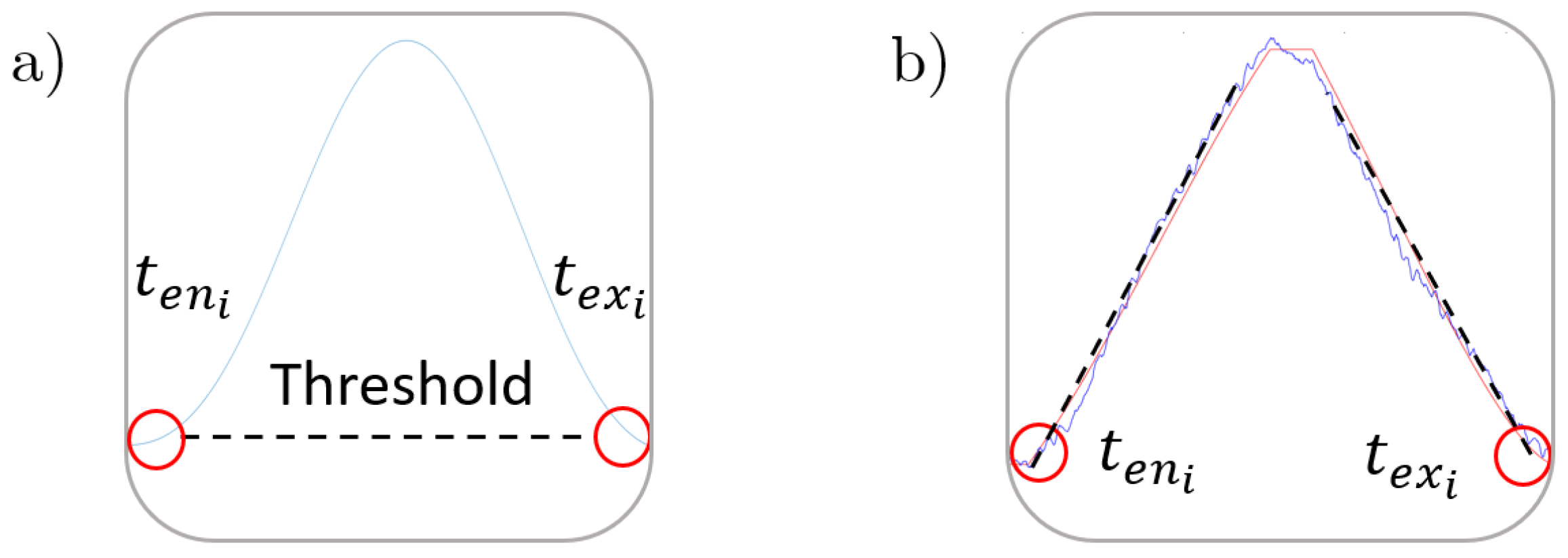
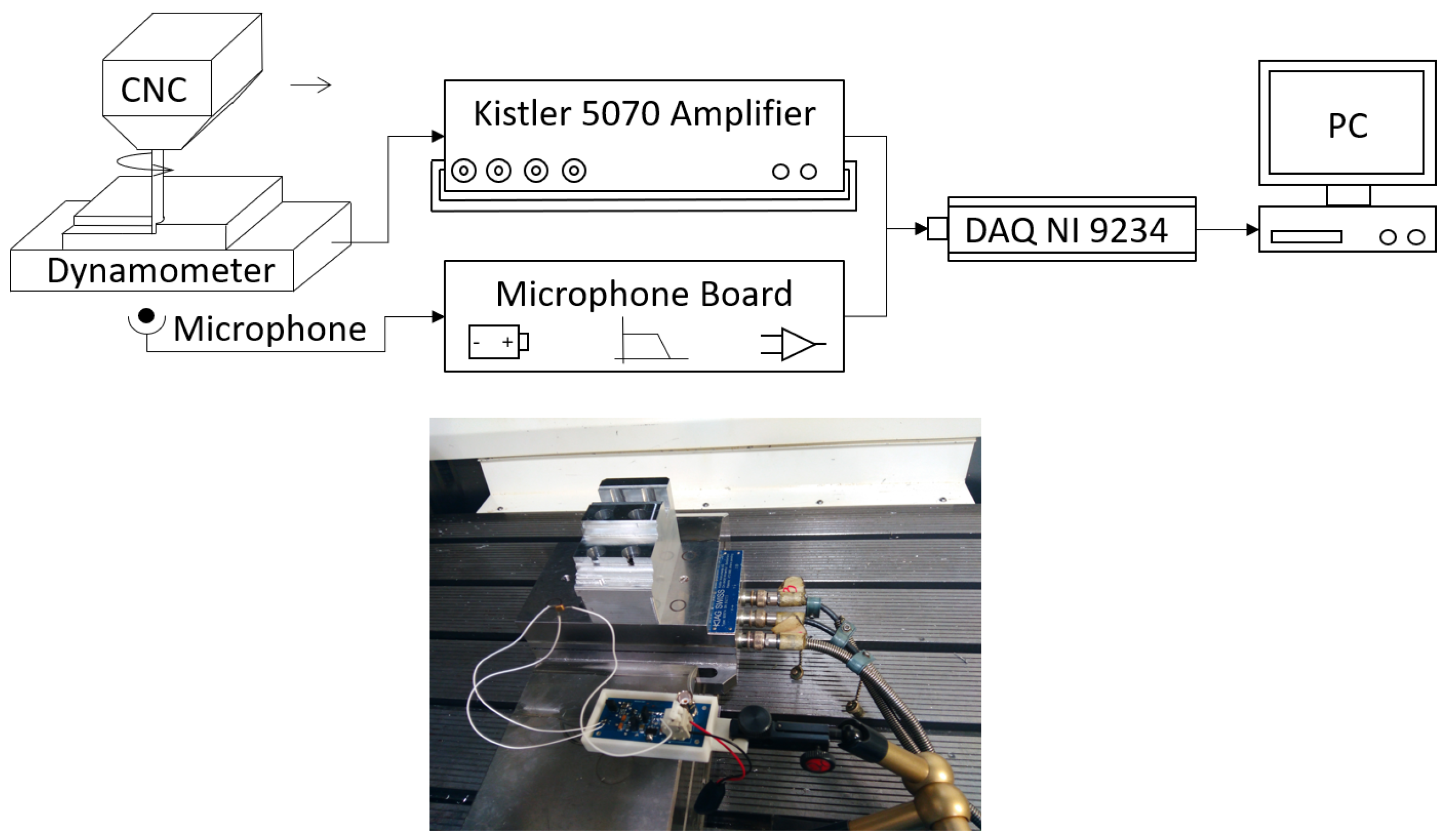

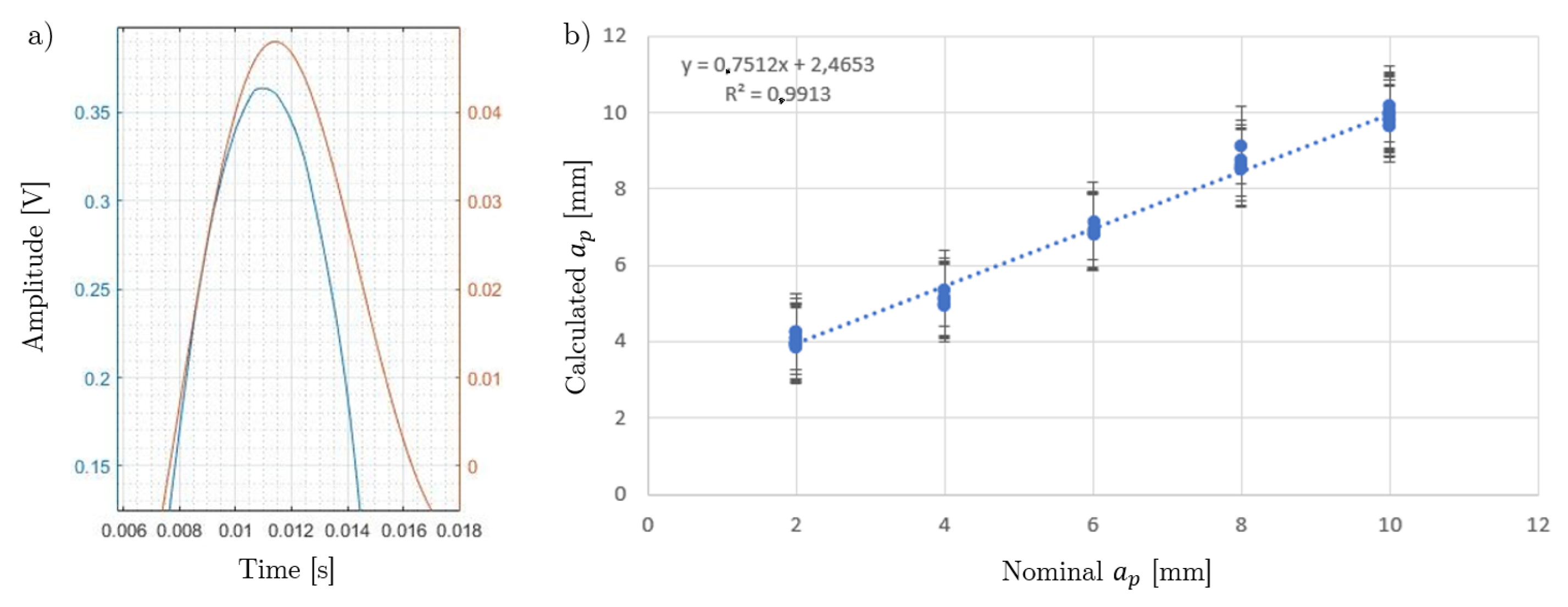

| Range | 10 Hz–10 kHz |
| Directivity | Omnidirectional |
| Sensitivity | −38 dBV/Pa |
| Signal to Noise Ratio | 63 dB(A) |
| DC Output at = 1.5 V | 0.73 V |
| Total Harmonic Distortion at 1 kHz | 0.15% |
| Dynamic range | ±5 kN |
| Threshold | <0.01 N |
| Pretensioning direction | Vertical |
| Frequency range | 1 Hz–2 kHz |
| Linearity, all ranges | <±1% |
| Depth of cut | ap [mm] | 2–10 |
| Width of cut | ae [mm] | 1 |
| Feed per tooth | fz [mm] | 0.08 |
| Spindle speed | n [rpm] | 1200 |
| Tool flute number | N [-] | 1 |
| Tool diameter | D [mm] | 8 |
| Tool helix angle | s [°] | 30 |
| Nominal ap [mm] | Calculated ap [mm] | STD [m] | Error [mm] |
|---|---|---|---|
| 2 | 4.14 | 174 | 2.14 |
| 4 | 5.21 | 185 | 1.21 |
| 6 | 7.10 | 280 | 1.10 |
| 8 | 8.70 | 300 | 0.70 |
| 10 | 9.80 | 259 | −0.20 |
| 2 | 4.12 | 159 | 2.12 |
| 10 | 9.82 | 241 | −0.18 |
| Dynamometer | Microphone | ||||
|---|---|---|---|---|---|
| Nominal ap [mm] | Calculated ap [mm] | STD [m] | Calculated ap [mm] | STD [m] | Difference [%] |
| 2 | 2.01 | 8 | 2.23 | 174 | 9.87 |
| 4 | 4.03 | 14 | 3.65 | 185 | −10.41 |
| 6 | 5.99 | 23 | 6.17 | 280 | 2.92 |
| 8 | 8.04 | 31 | 8.30 | 300 | 3.13 |
| 10 | 10.30 | 39 | 9.76 | 259 | −5.13 |
| Dynamometer | Microphone | ||||
|---|---|---|---|---|---|
| Nominal ap [mm] | Calculated ap [mm] | STD [m] | Calculated ap [mm] | STD [m] | Difference [%] |
| 2 | 2.01 | 8 | 2.01 | 14 | 0.50 |
| 4 | 4.03 | 14 | 4.00 | 25 | <0.01 |
| 6 | 5.99 | 23 | 5.99 | 38 | −0.17 |
| 8 | 8.04 | 31 | 8.00 | 62 | <0.01 |
| 10 | 10.30 | 39 | 10.01 | 53 | 0.10 |
© 2020 by the authors. Licensee MDPI, Basel, Switzerland. This article is an open access article distributed under the terms and conditions of the Creative Commons Attribution (CC BY) license (http://creativecommons.org/licenses/by/4.0/).
Share and Cite
Sio-Sever, A.; Leal-Muñoz, E.; Lopez-Navarro, J.M.; Alzugaray-Franz, R.; Vizan-Idoipe, A.; de Arcas-Castro, G. Non-Invasive Estimation of Machining Parameters during End-Milling Operations Based on Acoustic Emission. Sensors 2020, 20, 5326. https://doi.org/10.3390/s20185326
Sio-Sever A, Leal-Muñoz E, Lopez-Navarro JM, Alzugaray-Franz R, Vizan-Idoipe A, de Arcas-Castro G. Non-Invasive Estimation of Machining Parameters during End-Milling Operations Based on Acoustic Emission. Sensors. 2020; 20(18):5326. https://doi.org/10.3390/s20185326
Chicago/Turabian StyleSio-Sever, Andrés, Erardo Leal-Muñoz, Juan Manuel Lopez-Navarro, Ricardo Alzugaray-Franz, Antonio Vizan-Idoipe, and Guillermo de Arcas-Castro. 2020. "Non-Invasive Estimation of Machining Parameters during End-Milling Operations Based on Acoustic Emission" Sensors 20, no. 18: 5326. https://doi.org/10.3390/s20185326
APA StyleSio-Sever, A., Leal-Muñoz, E., Lopez-Navarro, J. M., Alzugaray-Franz, R., Vizan-Idoipe, A., & de Arcas-Castro, G. (2020). Non-Invasive Estimation of Machining Parameters during End-Milling Operations Based on Acoustic Emission. Sensors, 20(18), 5326. https://doi.org/10.3390/s20185326





